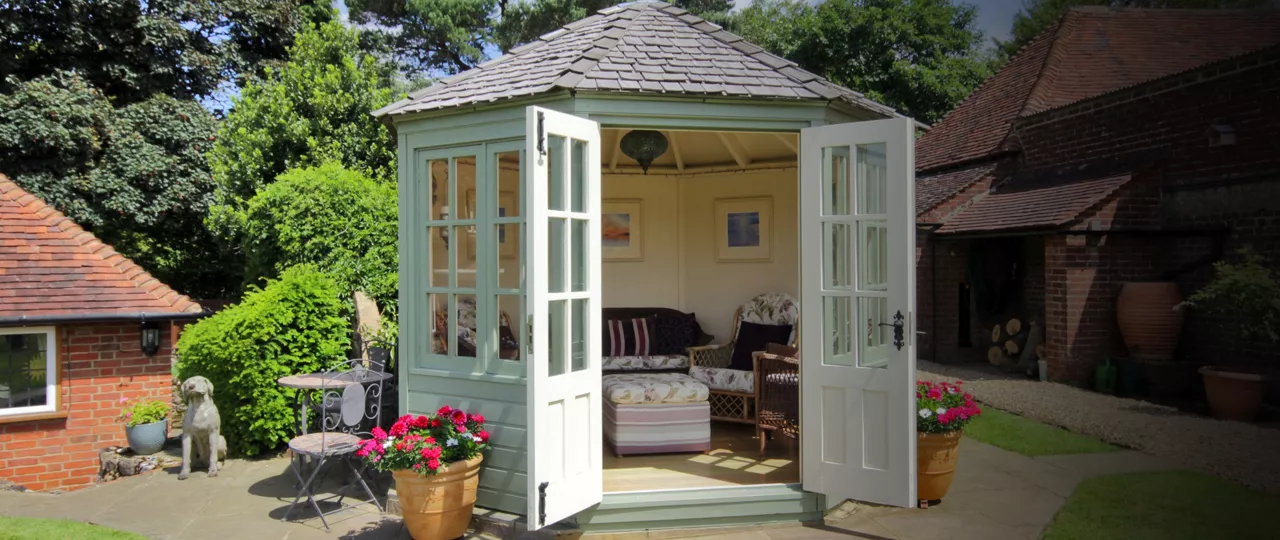
The great British Summer is in full swing. Earlier in the year, we brought in the season with our Glorious Gardens competition jointly hosted with Berkshire Life magazine to mark The Year of the English Garden.
One of the most quintessential features of our gardens are summerhouses, first making an appearance at the RHS Chelsea Flower Show during the early 1900’s where they were introduced as shelters for relaxation in warm weather. This would often take the form of small, roofed buildings on the grounds of large estates, but could also be built in gardens or parks.
Featured in all shapes and sizes, summerhouses can be ornate or simplistic and have taken many forms over the years in different brick, timber and glass frames. Evolving to take on a variety of roles in today’s modern garden, they’re often used for accommodation, storage and outdoor entertaining.
Do summerhouses require planning permission?
One reason for the increasing popularity of the summerhouse is that it adds an ‘extra room’ to a property without the homeowner requiring planning permission, due to its classification as an ‘outbuilding’ which is a permitted development. There are a few exceptions to this rule, including whether the land on which the property is built is ‘designated’ (e.g. a conservation area) and if the summerhouse is forward of the ‘principle elevation’ (i.e. if it is erected in the front garden). If you have any concerns about permissions, contact your local planning office for further advice.
What is the best location for a summerhouse?
Choosing the right position for a summerhouse depends on when and in what capacity it is being used, but generally speaking it makes sense to place it in a location that catches the warmth of the sun, which will make it cosy and bright to be in. Your chosen location should allow for a clear space of at least 18 inches wide on all sides, if possible, providing easy access for future installations and upkeep.
Are summerhouses easy to maintain?
Due to their direct exposure to the highs and lows of British weather, wooden summerhouses will require annual treatment with a good quality wood stain to extend its lifespan. Timbers such as pressure-treated timber or cedar are not as affected by such temperature changes and do not need regular treatment, although will eventually fade to a silvery grey colour. Door and window hinges should also be regularly oiled.
Summerhouses on show
Our Glorious Gardens competition saw some wonderful examples of purpose built summerhouses including the delightful Brockdale Cottage which was entered into the ‘Sustainable and Environmental’ category. The property features an avenue of bee-friendly crab apple trees as well as irrigated, raised flower beds alongside a steel and glass hand-built summerhouse.
Another notable entrant was Grade II listed Whitehouse Farm Cottage in Binfield, which features a 'secret' garden, characterful summer house, large greenhouse, an open-fronted potting shed and a water feature. The wide variety of flowering plants, shrubs and trees delicately frame a covered seating area to create an inviting relaxation and dining space.
Nuptown House is another example of a spectacular Grade II listed property offering access to a charming summerhouse within its extensive, mature grounds. From here, access may be gained to a swimming pool area, paddock and an attractive lake.
What better place to unwind from the labours of a long day gardening or enjoy a seasonal glass of Pimms with friends than from your own purpose built summerhouse? It can mean that even a bout of typical British weather will not stand in the way, or even when summer is over. Multi-purpose, beautiful and a great lifestyle addition. What’s not to love about summerhouses
